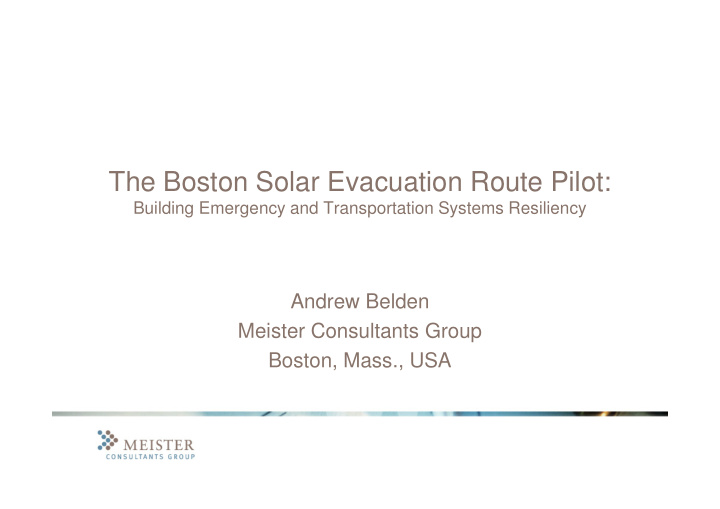



The Boston Solar Evacuation Route Pilot: Building Emergency and Transportation Systems Resiliency Andrew Belden Meister Consultants Group Boston, Mass., USA
The City of Boston •Capital of Massachusetts •About 600,000 residents •Largest metro area in New England •ICLEI City •Recently updated Climate Action Plan • Includes recommendation to address climate adaptation •Inaugural U.S. Department of Energy Solar America City
Renewable Energy in Emergency Preparedness and Energy System Resiliency •In the Spring of 2009 the Solar Boston program hosted a facilitated meeting of Boston emergency preparedness officials •Inter-departmental group included: • Mayor’s Office of Emergency Preparedness • • Boston Emergency Management Services Boston Emergency Management Services • Police Department • Public Health Commission • Transportation Department • Management Information Services
Solar Emergency Preparedness Facilitated Discussion • Significant concern about electricity grid failure: • Heat waves – 2003 East Coast Blackout – 2001 California Energy Crisis • Hurricanes – Less frequent in New England, but still a major concern – Less frequent in New England, but still a major concern • Ice storms – 2008 New England Ice Storm • Coastal flooding – Many of the region’s base load power plants are located along major waterways • Terrorism
Proposed Solar Applications for Emergency Preparedness • Large facility solar electric backups •Solar thermal systems for shelter facilities •Portable generators •Water purification systems •Water pumping systems •Vehicle anti-idling chargers • Communication repeaters • Variable message boards • Lighting and traffic control •Fold-out panels for ad hoc charging •Remote sampling and environmental monitoring •Solar powered vehicles
Evacuating Boston During a Power Outage •City of Boston has more than two dozen designated evacuation routes • Most lead from the City’s center to major interstate arteries • Currently marked by fixed signage •The Boston Transportation Management Center has direct control of half the city’s signalized intersections • • Allows transportation engineers to switch signals in response to traffic Allows transportation engineers to switch signals in response to traffic variations •The management center has a backup power supply that allows continuous operations in a power outage • However, in a blackout, most intersections in the City will not function
Evacuation Route Pilot Concept •Provide off-grid functionality to critical evacuation infrastructure along one City evacuation route • Grid-connected PV systems will provide continuous benefits during non-emergency operations •City chose the Washington Street – Hyde Park Avenue route due to the critical nature of the route and the existing fiber optic data connection to City Hall Transportation Management Center •Boston applied for and received $1.343 million from U.S. Department of Energy to develop the solar evacuation route pilot
Evacuation Route Component Technologies •21 solarized intersections •50 kW solar fueling station backup •27 LED-solar street lights along route •27 LED-solar street lights along route •5 solar variable message boards •10 solar radio repeaters
Solar Traffic Lights and Intersection Infrastructure •Solarized intersections • The City is procuring an engineering firm to design systems at each intersection along the route • PV and battery capacities will depend on intersection loads • PV and battery capacities will depend on intersection loads • Anticipated to be between 500W and 1kW • Final system designs will have to balance costs against hours of autonomous operations
Frontage Road Fueling Station PV Backup •The City’s main emergency vehicle fueling station requires backup power to operate during a power outage • The Department of Public Works will install a 50kW system on the roof of the building that houses the existing backup system • This system will net meter and displace grid power during non- emergency operations
Solar Street Lights •LED-solar street lights along route • In the event of a evacuation many city residents will need to leave the city on foot • Most commuters take public transit into the city meaning evacuating the city’s daytime population would largely be on foot • LED-solar street lights will provide off-grid lighting along the route • A number of companies offer integrated off-the-shelf systems for solar street lighting
Solar Variable Message Boards •During an evacuation, emergency personnel need to communicate to residents which routes to take out of the city • Boston currently has static signage along all its evacuation routes • Solar variable message boards will allow the city to direct traffic flow in real time during an evacuation event
Solar Powered Radio Repeaters •The city maintains of network of radio repeaters that is used by emergency responders • The city will identify the repeaters that have the greatest coverage • Solar and battery backup systems will be added at those sites to provide continuous operations in the event of a grid failure
Building Emergency Infrastructure Resiliency and Energy Assurance Planning Capacity •The Evacuation Route is a cross-cutting project that coordinate across several city agencies and cabinets • Emergency response agencies are already thinking about climate adaptation…but with a different frame of reference • How can we learn to speak the same language? •Introduces resiliency and renewable technologies to many city departments that would not typically be involved in sustainability planning that would not typically be involved in sustainability planning •Opportunity for project-based city resiliency policy development • Boston is now working on a city-wide energy assurance plan •Successful pilot could lead to city-wide rollout funded with Department of Homeland Security support
Thank you Andrew Belden Project Consultant Meister Consultants Group andy.belden@mc-group.com
Recommend
More recommend